RSV Nuyina icebreaker
RSV Nuyina icebreaker current position
The current location of RSV Nuyina icebreaker is in Southern Ocean cruising en route to CASEY. The AIS position was last reported 10 minutes ago.
Current PositionSpecifications of RSV Nuyina icebreaker
| Year of build | 2020 / Age: 5 |
| Flag state | Australia |
| Builder | Damen Shipyards (Galati, Romania) |
| Class | PC3 diesel icebreaker |
| Ferry route / homeports | Hobart (Tasmania Australia) |
| Building cost | AUD 1,91 billion (USD 1,46 billion / EUR 1,189 billion) |
| Engines (power) | MAN (26.6 MW / 35671 hp) |
| Propulsion power | 7.4 MW / 9924 hp |
| Speed | 16 kn / 30 km/h / 18 mph |
| Length (LOA) | 160 m / 525 ft |
| Beam (width) | 26 m / 85 ft |
| Gross Tonnage | 20200 gt |
| Passengers | 117 |
| Crew | 32 |
| Decks | 10 |
| Owner | Australian Antarctic Division |
| Operator | DMS Maritime (Defence Maritime Services) Australia |
RSV Nuyina icebreaker Review
Review of RSV Nuyina icebreaker
RSV Nuyina is the new Australian icebreaker, PC3-classed as "research and supply vessel". The ship supports Australia's Antarctic bases by deploying various cargo vehicles (landing barges, amphibious trucks, helicopters). It also has a large scientific moon pool (in-hull platform) that serves marine research in both water and sea ice. From the platform are launched and retrieved ROVs (remotely operated vehicles) and various sampling equipment.
The vessel (IMO number 9797060) is now Australia-flagged (MMSI 503000183). It was previously St Vincent Grenadines-flagged (MMSI 375897000) and registered in Kingstown.
History and ownership
Ship's design was developed by Knud E Hansen (Danish naval architects / marine engineering company), with its construction managed by Damen Group (Holland). The icebreaking vessel was built at Damen Shipyards in Galati (Romania).
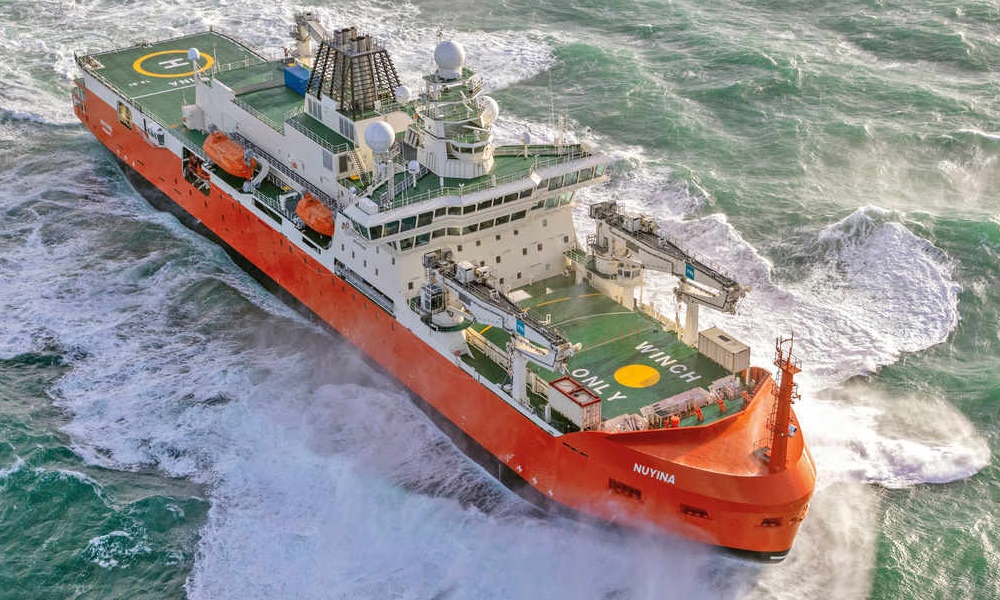
On April 28, 2016, was signed the shipbuilding contract between DMS Maritime (Defence Maritime Services, Australia - via Serco Defence / DMS subsidiary) and Damen Group. The deal included vessel design, delivery, and maintenance. Damen Schelde Naval Shipbuilding (Holland) provided engineering and project management. Damen Shipyards Galati carried the construction and outfitting works. Alewijnse Marine (Romania) was contracted to provide engineering, delivery, and installation of ship's electrical systems (main engines control, propulsion-thruster control, integrated management).
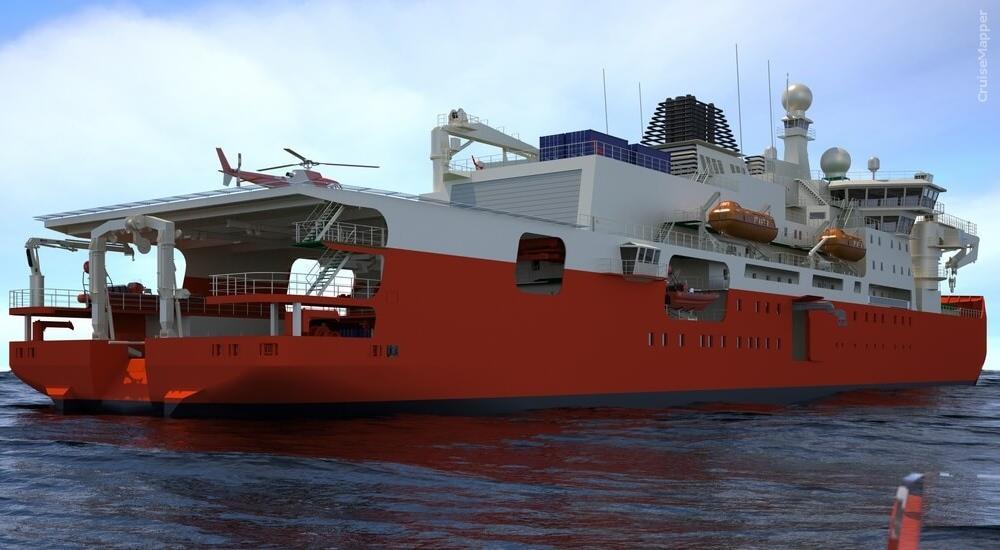
Until 2019, AAD used the icebreaker Aurora Australis as ASRV (Antarctic Supply Research Vessel). Since 1989, the ship is chartered from P&O Polar (since 2006 owned by DP World Dubai). Australian government's plan to purchase a new icebreaking ship was announced in October 2015.
The shipowner AAD (Australian Antarctic Division) is a division of Australia's "Department of the Environment and Energy" (environment protection, biodiversity conservation, energy policy). AAD undertakes science research programs and projects in Antarctica and the Southern Ocean also conducts and supports collaborative researches with other organizations and administers and maintains Australia's Antarctic and sub-Antarctic territories.
- AAD uses air transportation - between Australia and Antarctica and within Antarctica. Aircraft and services (via contracts with private companies) are provided annually - between November and February. An Airbus A319 (owned by Skytraders) operates to and from Antarctica (Wilkins Runway aerodrome in Wilkes Land - approx 65 km / 40 ml from Casey Station).
- Within Antarctica, services for AAD are provided by two fixed-wing planes (CASA 212-400) and three helicopters (single-engine Airbus H125). Fixed-wing planes (chartered from Skytraders) are equipped with skis and operate between Wilkins aerodrome and the runways at the permanent bases. Helicopters are chartered from Helicopter Resources Pty Ltd (also serving mainland Australia and Tasmania).
DMS Maritime (Australia) is a state-owned company founded in 1997. It provides port and vessel management services to the country's Defence Force, Border Force, and Navy. DMS operates 8 ocean ships and over 100 harbor vessels.
The new icebreaker supplies with cargo, equipment, and personnel Australia's four permanent bases - three stations in Antarctica (Mawson, Davis, Casey) and one on Macquarie Island (Tasmania). Additionally, the ship serves as a research laboratory with passenger capacity up to 116 scientific staff.
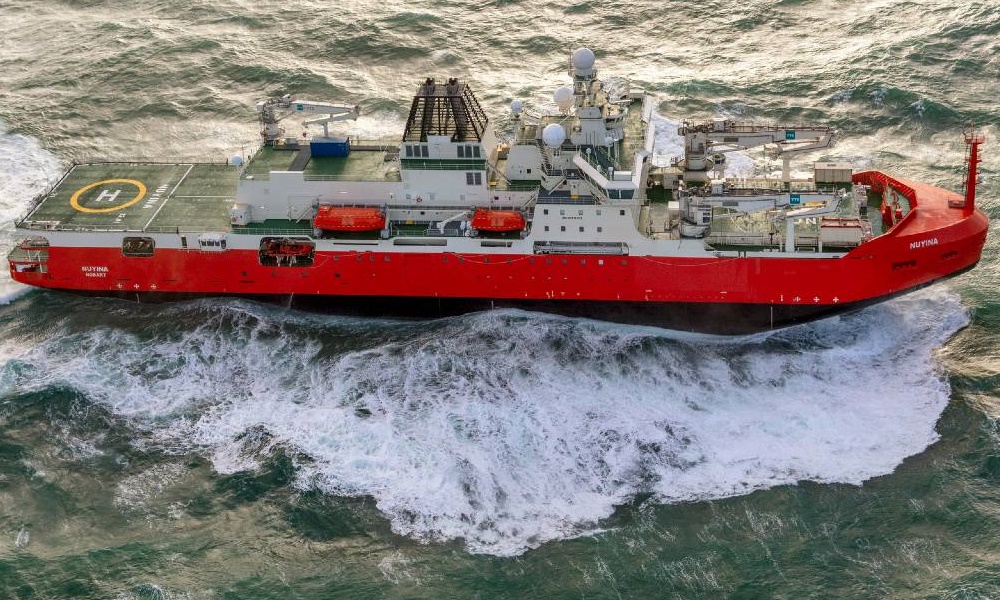
RSV Nuyina vessel details
The vessel is fitted with containerized laboratories for meteorological, oceanographic and biological research. It also has an aft trawl deck for deployment and recovery of research instruments at sea. The hangar and helideck (2 helipads - forward and aft) allow operations with up to four helicopters.
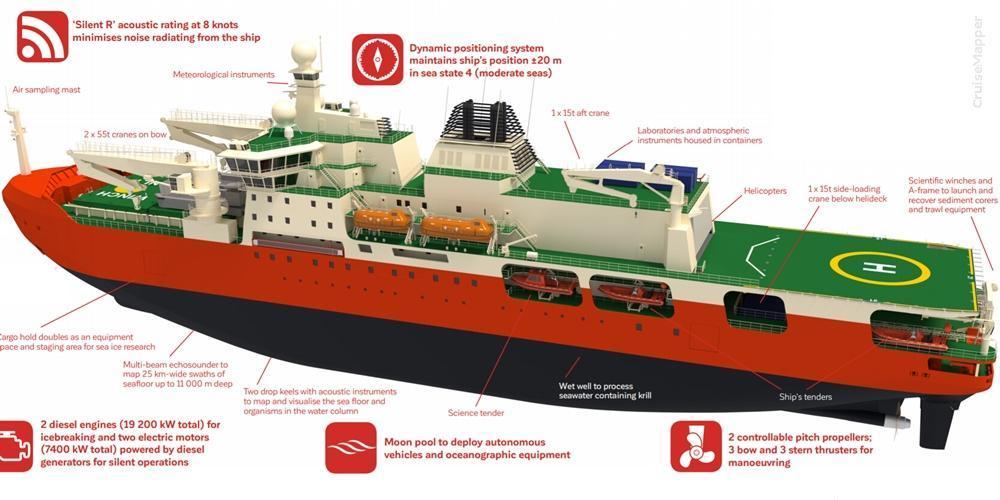
The icebreaker features latest technology equipment for ocean and polar surveys (acoustic, seismic, subsea), including ADCP (acoustic Doppler current profiler), echo sounder, biological and omnidirectional sonars, seabed mapping, monitoring systems, meteo weather station, cargo handling facilities, airborne robots, measuring instruments (atmospheric gases, cloud properties, ice and sea conditions). ROVs and AUVs (remotely operated and autonomous underwater vehicles / robotic submarines), 4 tender boats (3 crew, 1 science) and 4 motorized lifeboats (full-capacity).
- The vessel has 1 Mess hall (lounge-dining room), Science Winch Room, Wet Well, Moon Pool, medical facility, 2 helipads.
- Max Draught: 9,3 m (31 ft)
- Displacement tonnage: 25500 tons
- Deadweight: TBA
- Icebreaking capacity: 1,7 m (5 ft)
- Ice class PC3 - the ship has ice-strengthened hull allowing operations in pack ice and temperatures down to -35 C (-31 F).
- Endurance - 90 days
- Max speed 30 kph (18 mph), Cruising speed 22 kph (14 mph), Ice speed 5,6 kph (3,5 mph in pack ice with thickness up to 1,65 m / 5 ft)
- Cargo capacity: 96 TEU-containers below decks, plus 60 TEUs above deck (cargo and containerized labs)
- Fuel capacity - 1900 m3 (supply fuel)
- Heavy lifting capacity - 1200 tonnes of cargo, 4 large cranes (two 55-ton / bow, one 15 ton / portside; one 15-ton / aft) plus smaller cranes on work deck
- Hangar capacity - up to 4 helicopters (Eurocopter AS350) or two Sikorsky S92s
- Powerplant: two MAN marine diesel engines (total power output 19,2 MW) used for icebreaking, plus two diesel-electric motors (combined power 7,4 MV, powered by gen sets)
- Propulsion: combined power 26,6 MW, 2 drive shaft with CPPs (controllable pitch propellers with nozzles) plus 6 thrusters for maneuvering (3x bow, 3x stern)
The ship's laboratory and office facilities (total size 500 m2) are served by 116 AAD personnel accommodated in climate-controlled staterooms. The Infirmary is served by a resident doctor.
The fore-located retractable boom serves instruments measuring snow and ice thickness.
(hull) The fore-located multi-beam echosounder is used for seafloor mapping (max-width 25 km, max depth 11 km).
(hull) Two drop keels (retractable fin keels preventing drifting) are equipped with acoustic instruments for mapping the seafloor and visualizing the organisms in the water column.
The midship-located scientific moon pool (aka "wet porch") is a floor opening in the hull that gives direct access to the water/ice below. It allows the crew to deploy underwater instruments, including ROVs and AUVs (remotely operated and autonomous underwater vehicles / robotic submarines).
Nuyina is the world's only ship with a watertight room (aka "wet well") processing seawater for marine organisms. System's max capacity is 1800 liters per minute. The vessel has two high-powered landing barges - designed, engineered and built by Taylor Bros Pty Ltd (Tasmanian marine engineering company). Each barge has cargo capacity 45,5 tons and carries trucks from the ship to the shore for unloading and reloading supplies.
The following ship deckplan shows the location of staterooms and all main facilities and equipment.
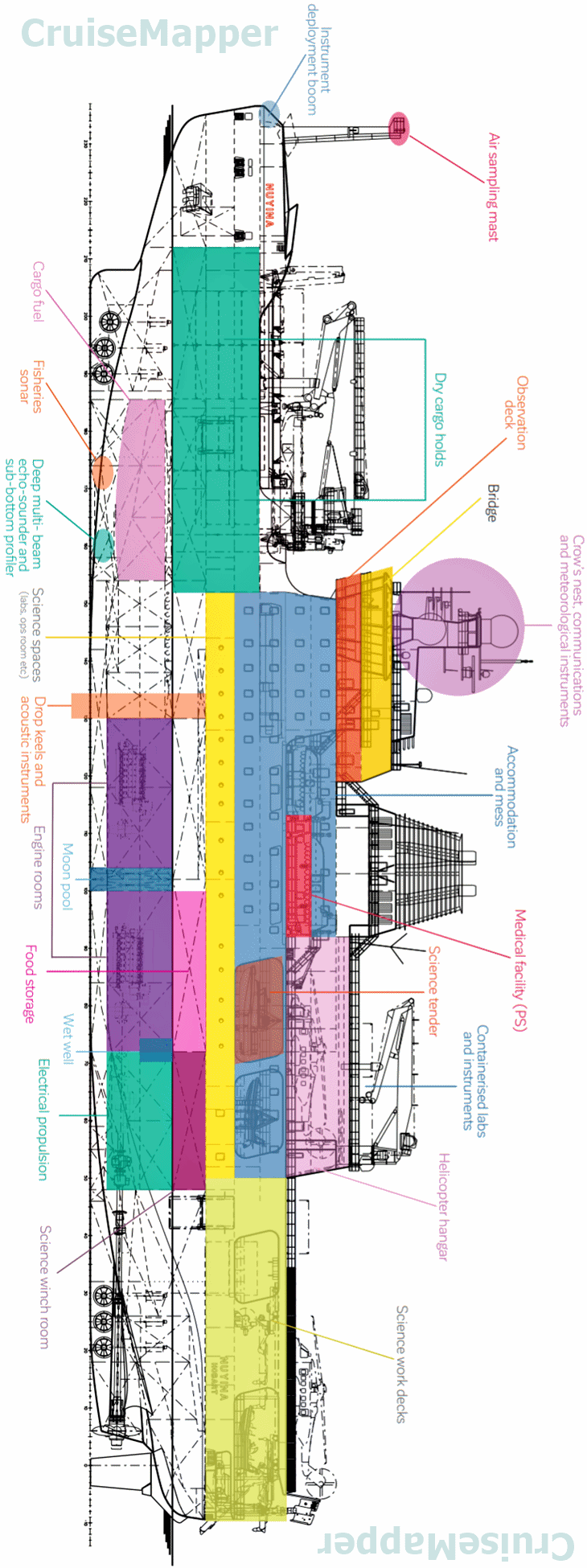
Note: In the case of poor AIS coverage, tracking the vessel's current location will be impossible. You can see the CruiseMapper's list of all icebreakers and ice-breaking research ships in the "itinerary" section of our Icebreakers hub. All states and their fleets are listed there.
RSV Nuyina icebreaker Wiki
The vessel's steel-cutting ceremony was in May 2017, at DAMEN's shipyard in Galati, Romania. With the keel-laying ceremony (August 2017) started the construction. During the ceremony, four coins (Danish, Dutch, Romanian, Australian) were welded to the keel (hull-bottom).
In March 2018, nearly 70% of all the 10,000 tons of steel were cut and the keel was completed. In May 2018 was delivered the propulsion system (thrusters, propellers, hubs) as well as the anchors and ice knives.
On September 25, 2018, the hull was launched (floated out) from drydock. The procedure took 2 days and was achieved by raising drydock's water level by 6 m (20 ft). Then the ship was maneuvered 250 m to shipyard's outfitting quayside berth. The construction process was based on the positioning of 57 pre-fabricated blocks (hull and superstructure modules) combining 229 steel sections. Ship's 10-deck height is 50 m (165 ft).
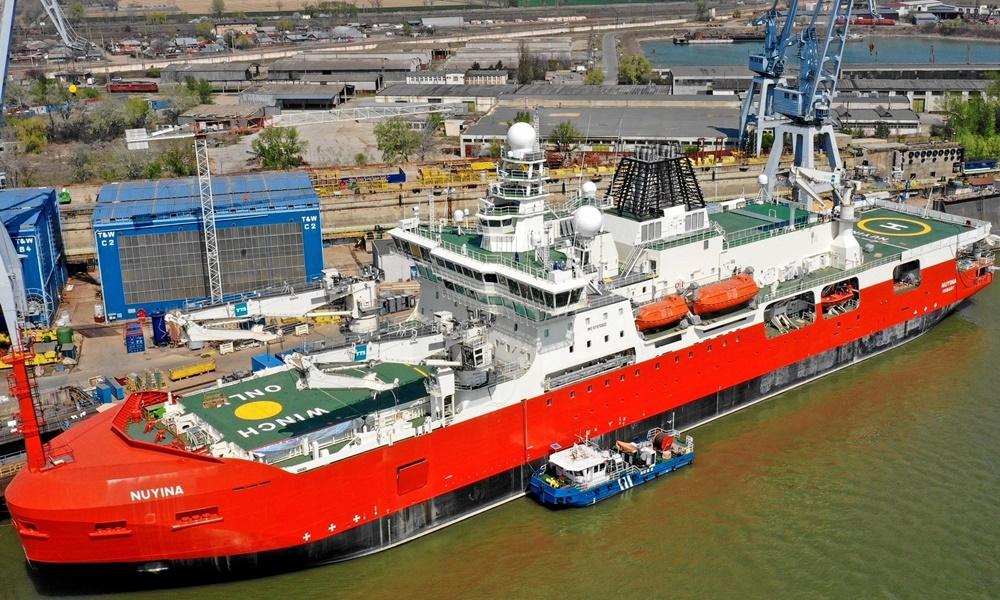
In early-August 2020 started the icebreaker's repositioning from Romania to Holland (Vlissingen) for the North Sea trials. The month-long towing allowed teams of equipment installers to access the vessel for final commissioning of its propulsion, electrical and navigation systems as the works at the Galati Shipyard were temporarily suspended due to the Coronavirus pandemic.
The towing operation was carried out by 1x 50-m tugboat (on the sea voyage) and 3x smaller tugs (assisting on the inland waterways). The towing was mandatory as the vessel was still not certified to conduct international voyages under its own power. In early October, after a month-long repositioning (~7000 km) RSV Nuyina arrived at DSNS (Damen Schelde Naval Shipbuilding/Vlissingen’s shipyard) for final testing and commissioning. Sea trials started on November 23rd.
RSV Nuyina departed the Netherlands on August 31, 2021. The 24,000 km relocation voyage to Tasmania ended in Hobart on October 16th.
The ship's name (Nuyina) was chosen by Australian students (via online competition) and officially announced on September 29, 2017. It means " southern lights" in the Tasmanian Aboriginal language palawa kani.
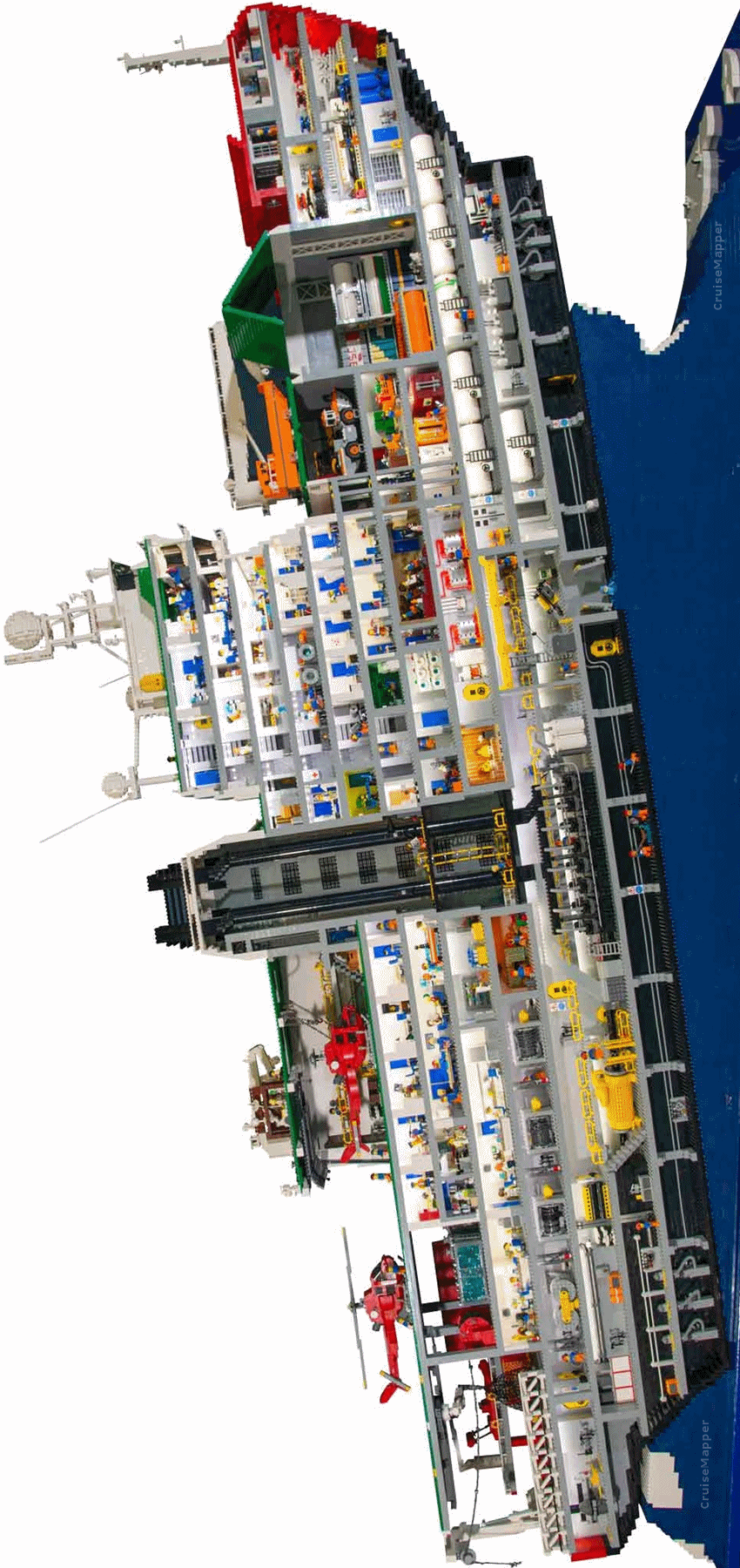
After its delivery (2021), RSV Nuyina replaced the icebreaker Aurora Australis (operated by AAD / Australian Antarctic Division). The vessel's projected lifespan is at least 30 years.
The modern icebreaker is operated by Serco Defence and homeported in Hobart Tasmania. Its inaugural cruise to Antarctica was initially planned for summer 2020-2021.
Follows the 3D animation video about the newest Australian icebreaking ship.
Due to the vessel's delayed delivery, for summer 2021 season, the Australian Antarctic Division chartered MPV Everest (2017-built Offshore Construction Vessel) to resupply Australia's Antarctic bases and Macquarie Island. The ship charter deal is for at least 90 days. MPV Everest (IMO number 9769130) is an ice-class multi-purpose ship operated by the Dutch company MCS (Maritime Construction Services BV). The contracted ship has max icebreaking capacity 1 m (3 ft), LOA length 140 m (459 ft), max passenger capacity 100, max cargo capacity 96 TEU-containers (on outer decks), a helipad (positioned above the Wheelhouse).
The new icebreaker Nuyina was scheduled to arrive in homeport Hobart in 2020-Q3, but due to the global pandemic, its construction was temporarily halted and the delivery was delayed.






